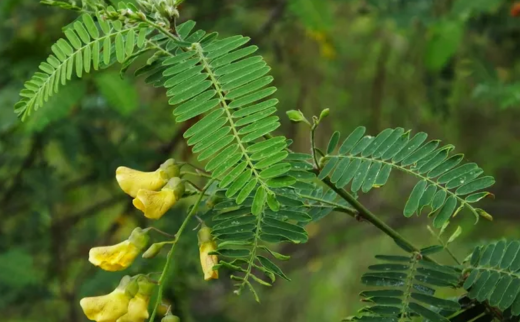Jayanti/ Egyptian Rattle Pod/ Egyptian River Hemp/ Sesbania sesban Merrill – Ayurvedic Uses & Benefits
Abstract
Sesbania sesban, commonly known as the Egyptian rattle pod or Jayanti in Ayurveda, is a multipurpose plant valued for its medicinal, agricultural and environmental uses. This leguminous shrub is traditionally used to manage a variety of ailments, especially those related to inflammation, fever and liver disorders. It is praised in Ayurveda for its detoxifying and healing properties. The plant also supports soil fertility through nitrogen fixation, making it an eco-friendly crop. Its widespread availability and multiple therapeutic effects have made it a vital herb in traditional healing systems. Recent pharmacological studies further validate its health benefits.

Introduction
Sesbania sesban Linn is a well-known medicinal plant commonly found throughout the plains of India and other tropical countries. Among the six species of the genus Sesbania, S. sesban is popularly known as ‘Egyptian sesban’ and is frequently grown in tropical regions for its multipurpose benefits. In addition to its ecological role in nitrogen fixation and use as a windbreak, the plant holds considerable medicinal importance. Ethnomedicinal claims highlight its therapeutic potential. For instance, a poultice made from its leaves is traditionally used to promote the suppuration of boils and abscesses, as well as the reduction of inflammatory rheumatic swellings. Moreover, the juice extracted from fresh leaves is known for its anthelmintic (worm-expelling) properties.
Scientific Classification
- Kingdom: Plantae
- Subkingdom: Tracheobionta
- Division: Magnoliophyta
- Class: Magnoliopsida
- Order: Fabales
- Family: Fabaceae
- Genus: Sesbania
- Species: Sesbania sesban (L.) Merr.
Synonyms
- Sookshma Moola: The root of Sesbania sesban is very thin.
- Jayanti: One of the primary Sanskrit names of the plant.
- Vijaya: Symbolises victory
- Jaya: A synonym denoting success and triumph.
- Harita: Refers to the plant’s greenish appearance.
- Bala Mota: Indicates strength or robustness associated with the plant.
- Aparajita: Means “unconquered,” a revered synonym in Ayurveda.
- Vikranta: Signifies courage and boldness; another traditional name.
Vernacular Names
- Arabic name: Sesaban
- Bengali name: Jainti, Jayant
- Burmese name: Yay-tha-kyee, Yethugyi
- English name: Common Sesban, Egyptian Rattle Pod, Frother, River Bean, Sesban, Sesbania
- Hindi name: Dhunchi, Jainti, Jait, Rawasan
- Indonesian name: Janti, Jayanti, Puri
- Javanese name: Janti
- Kannada name: Mullu Jeerangi
- Luganda name: Mubimba, Muzimbandeya
- Punjabi name: Jainta
- Sanskrit name: Jayanti, Jayantika
- Spanish name: Añil Francés, Tamarindillo
- Tamil name: Champai, Chithagathi, Karunchembai
- Telugu name: Errajiluga
- Thai name: Sami, Saphaolom
- Vietnamese name: Dien-Dien
Habitat
The precise origin of Sesbania sesban remains uncertain; however, it is extensively distributed and cultivated across tropical regions of Africa and Asia. The plant has also been introduced to tropical areas of the Americas. Although considered exotic to Ethiopia, it is believed to have originated in East Africa.
Morphology
Sesbania sesban is a narrow-crowned, deep-rooted shrub or small tree that grows between 1 to 7 meters in height, typically with a single main stem but capable of developing multiple side branches, especially when spaced apart. Its wide branching angle (45–60 degrees) often gives it a shrubby, spreading appearance. The leaves are paripinnate, long and narrow, with numerous pairs of oblong or rounded leaflets that are typically asymmetrical at the base and may appear glaucous. Flowers are visually striking, ranging in colour from yellow and red to purplish or variegated, occasionally white, and are borne on slender pedicels either singly or in pairs on short axillary racemes. Though attractive, they are often unpleasantly scented. The pods are pale yellow, linear and typically 10–20 cm long, containing up to 40 oblong or subquadrate seeds, which are brown or dark green mottled with black.
Varieties
There are three varieties of Jayanti on the basis of flower colour, which are as follows:
- Var. typica Prain (Yellow flowers)
- Var. picta Prain (Flowers having Violet spots)
- Var. bicolor W. & A. (Dark brown or violet flowers)
Classical Categorisation
- According to Raj Nighantu – Satahvadi Varga
Ancient Verses
ज्ञेया जयन्ती गलगण्डहारी तिक्ता कटूष्णानिलनाशनी च ।
भूतापहा कण्ठविशोधनी च कृष्णा तु सा तत्र रसायनी स्यत् ।।
Jayanti is known for its effectiveness in goitre (Galaganda). It is pungent, bitter, hot and quells vitiated Vata dosha. It clears the throat. The black (Krishna) coloured variety of Jayanti is considered rejuvenative.
Ayurvedic Properties
- Taste (Rasa): Bitter (Tikta), Pungent (Katu)
- Physical property (Guna): Light (Laghu)
- Potency (Veerya): Hot Potency (Usna)
- Post-digestion effect (Vipaka): Katu (Pungent)
- Effect on tridosha: Balance Vata dosha
Therapeutic Properties
- Mutrakrichra: Useful in managing dysuria (painful urination) and urinary retention
- Visha: Beneficial in treating toxic conditions and poisoning
- Galaganda: Effective in cervical lymphadenopathy (swelling of lymph nodes in the neck)
- Bhutapaha: Helpful in psychiatric and psychological disorders
- Kantha Vishodhini: Acts as a throat cleanser and supports vocal clarity
- Vatahara: Balances Vata Dosha; useful in conditions like neuralgia, paralysis, bloating and constipation
- Rasayana: Functions as a rejuvenative (anti-ageing), promoting cellular and tissue regeneration
Systemic Actions
External
The leaf paste of Sesbania sesban helps reduce swelling and pain, supports wound healing, and is beneficial for skin and hair conditions like baldness and greying. Its juice has antimicrobial properties, while seeds and roots are used externally for bites and poisoning. Flowers act as antipyretics. Hot leaf paste relieves abscesses, cysts, joint swellings and goitre. Leaf decoction also serves as an effective wound cleanser.
Internal Uses
- Digestive System: Acts as a carminative, digestive stimulant, and possesses antimicrobial activity. Seed powder and bark juice are traditionally recommended for improving appetite and treating diarrhoea. Leaf juice is useful in managing intestinal worm infestations.
- Circulatory System: Supports the purification of blood and helps eliminate toxins from the bloodstream.
- Excretory System: Helps in reducing urine output. Leaf decoction is advised in managing conditions like Ikshumeha (diabetes-like symptoms).
- Respiratory System: Being hot in nature, it balances Kapha dosha. Leaf decoction is beneficial in conditions such as hoarseness of voice, nasal congestion, running nose and common cold.
- Reproductive System: Flower powder mixed with jaggery and sour gruel is traditionally consumed from the third day of menstruation to prevent conception. Seed powder functions as a uterine stimulant and is beneficial in treating amenorrhea and dysmenorrhea.
- Tvak (Skin): The root and bark are effective in managing various skin diseases. Root, when taken with milk, is helpful in treating leucoderma.
- Tapakrama (Febrile Conditions): Encourages sweating and helps lower fever. To prevent chickenpox, 20–25 seeds are powdered and taken with cow ghee.
- Satmikarana (Rejuvenation): Root acts as an anti-toxic agent, enhances vitality and is useful in general weakness or debility.
- Pliha (Spleen): Seeds are found beneficial in reducing the enlargement of the spleen (splenomegaly).
Chemical Composition
- Primary phytochemicals include carbohydrates, glycosides, proteins, amino acids, saponins, tannins, alkaloids, phenolic compounds and flavonoids.
- Leaves and pods contain cholesterol, campesterol and beta-sitosterol.
- Flowers are reported to contain cyanidin, anthocyanins and delphinidin glucosides.
- Pollen and pollen tubes have been found to contain alpha-ketoglutaric acid, oxaloacetic acid and pyruvic acid.
- Seeds contain oleanolic acid, stigmastane-5,24(28)-diene-3β-O-β-D-galactopyranoside and galactomannan.
- Roots yield oleanolic acid 3-β-D-glucuronide, which has been isolated and studied for pharmacological properties.
- Dry matter analysis shows higher amounts of crude protein and crude fibre in dried leaves compared to fresh leaves.
- As per the Ayurvedic Pharmacopoeia of India, the plant contains notable amounts of calcium and phosphorus.
Modern Overview
Antioxidant Activities
Anthocyanins were extracted from the flower petals of Sesbania sesban using methanol and acidified methanol, and their antioxidant potential was evaluated. The extracted anthocyanins demonstrated dose-dependent free radical scavenging activity, effectively neutralising DPPH radicals, superoxide anions and hydroxyl radicals.
Practical Uses
- For worm infestation: Decoction of leaves is administered with honey.
- For skin wounds and boils: A paste of leaves applied externally to promote healing.
- For fever: Leaf decoction given twice a day helps reduce body temperature.
- For liver health: Leaf juice mixed with sugar candy is used to support liver function.
- For cough: Warm leaf juice with a pinch of black pepper acts as a natural expectorant.
- For urinary issues: Leaf infusion is used as a mild diuretic.
- For oil secretion: Seed paste has anti-inflammatory properties and helps control oil secretion.
- For itching and hives: Its ointment is used to treat itching and hives.
- For eczema: External application of seed paste is beneficial for eczema and psoriasis.
- For inflammation: Seed paste is applied on scorpion bites to relieve pain and inflammation.
- For hair growth: Leaf paste is applied to the hair before bathing to promote hair growth.
Part Used
- Roots
- Bark
- Flowers
- Seeds
Dosage
- Decoction – 50–100 ml
- Powder – 2–6 gms
Conclusion
Sesbania sesban, or Jayanti, is a versatile medicinal shrub known for its wide range of healing properties. From detoxifying the body to treating fevers, wounds and digestive ailments, this plant plays a significant role in traditional and modern herbal medicine. Its easy cultivation and broad therapeutic use make it an ideal choice for holistic wellness. Further scientific research may help unlock more clinical applications, integrating it deeper into global healthcare systems.



